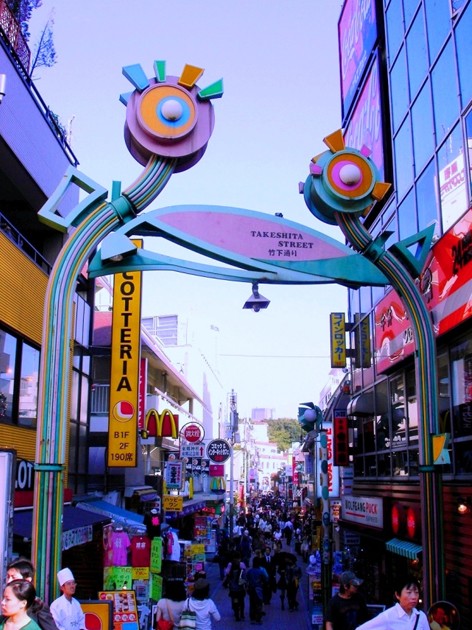 Naomi Shimoda writes: Few people can imagine a place where it’s totally normal to walk down the street with a teenage boy decked out in brooding gothic gear on your left and a young girl donning a dainty French maid costume embellished with lace on your right. On Takeshita Street in Harajuku, Tokyo’s centre of fashion and people-watching, this is fairly commonplace.
Naomi Shimoda writes: Few people can imagine a place where it’s totally normal to walk down the street with a teenage boy decked out in brooding gothic gear on your left and a young girl donning a dainty French maid costume embellished with lace on your right. On Takeshita Street in Harajuku, Tokyo’s centre of fashion and people-watching, this is fairly commonplace.
A demure, pastel coloured arch with the name of the street printed modestly on it marks the beginning of the famous strip, but is in no way an indication of the wacky street fashions to be witnessed up ahead. The usually quiet shopping strip transforms into a miniature catwalk for teenagers to show off their wackiest attire on weekends, most often conforming to particular subcultures.

Stepping foot on Takeshita Street is comparable to exploring a pop culture exhibition with real life exhibits, as the intricate detail of the elaborate outfits worn fearlessly by the teenagers is an impressive form of creative expression.
Here, you can witness teens who are mere school students during the week become celebrities on the weekend, just like a Sailor Moon transformation, enjoying the attention thrown at them by paparazzi in the form of tourists.
Harajuku is home to a wide spectrum of subcultures you never even knew existed. Gothic Lolita girls wearing Victorian style outfits adorned with ruffles and clutching frilly black lace parasols in their hands, as if to shield their delicate, pale skin from the autumn sun’s non-existent rays. They are surrounded by a myriad of other subcultures, including chain-smoking punks with mohawks that seemingly defy gravity and encompass the colours of the rainbow, to “Decoras” — girls who wear eye-popping candy brights and clutch teddy bears, reminiscent of childhood playfulness. When tourists whip out a camera in record time and get snap happy at the sight of such craziness, the locals here don’t bat a single mascara-coated lash.

The iconic store on Takeshita Street named “Takenoko” captures the eccentricities of Harajuku style, and could easily compete with Lady Gaga’s outrageous fashion choices. My vision is blurred upon entry by the clashing colours and textures of the extreme fashion pieces on display, ranging from full bodied, bright coloured leather suits (which even members of The Scissor Sisters would shy away from), to glittery, sequinned cowboy suits belonging in some distant fictional space age. This cross-dresser’s paradise spawned a Harajuku-based subculture hailed as the “Takenoko clan”, immortalising their pioneering position in this kooky fashion movement. The style is so unique to the store that there is a strict “No Cameras” rule so as to protect the endangered subculture’s distinctiveness.
Do these teenagers just dress up in extravagant costumes for the hell of it? The underlying motivations go deeper than the seemingly shallow surface of aesthetic enjoyment. Although the fashionistas of Harajuku appear to merely bask in the attention thrown at them by awed onlookers, many are making a statement against social repression they encounter in their everyday lives.
Often considered a country of stark contrasts between traditional and contemporary culture, the teenage inhabitants of Harajuku struggle with the contrast in the modest demeanour expected of the Japanese in public and their true inner self. Socially, the Japanese can be introverted and studious, caused in part by highly demanding school and work commitments. Largely though, Japanese society has rigid expectations of social behaviour firmly entrenched in their way of life. As a native of Japan, I know and understand the stressfulness of living amidst a culture where a certain degree of compliance with the mainstream and oppression of individualism is expected.
Walking the Takeshita Street runway in whatever clothes you fancy is a form of escapism for these teenagers. Some Westerners imagine a typical escape to be a holiday exploring the exotic east. For the Japanese however, revealing your true self on a public platform where individuality can be blatantly expressed is their way of escaping from the shackles of conformity which bind them everyday. The careful calculation of each outfit to perfection demonstrates the seriousness of these teens in their creative expression of their personality and their protest against social uniformity. Some even experience bullying and are marginalised by other students in school, as tall poppies are cut down and pressures to conform take their place. Who else can encapsulate this angst and rebellion against social order better than teenagers?
Harajuku’s electric atmosphere and the showcase of cutting edge fashions worn by teens’ alter egos entice the curious to a place where the bizarre is considered normal. Nothing is too weird — anyone can be who they want to be without being judged here. The phrase “Only in Harajuku” is a common one, and it makes sense — Harajuku celebrates being unconventional and is damn proud of it. The amateur catwalk display of outlandishly dressed subcultures attracts the crowds, but the celebration of individuality is what makes me want to return to Takeshita Street again and again.
Naomi Shimoda is studying Media and Communications at the University of Melbourne.







Crikey is committed to hosting lively discussions. Help us keep the conversation useful, interesting and welcoming. We aim to publish comments quickly in the interest of promoting robust conversation, but we’re a small team and we deploy filters to protect against legal risk. Occasionally your comment may be held up while we review, but we’re working as fast as we can to keep the conversation rolling.
The Crikey comment section is members-only content. Please subscribe to leave a comment.
The Crikey comment section is members-only content. Please login to leave a comment.